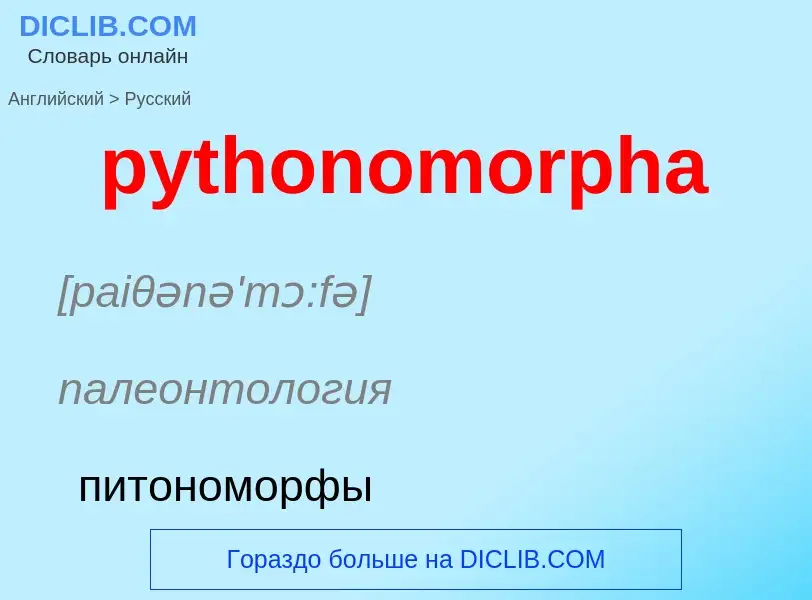Translation and analysis of words by ChatGPT artificial intelligence
On this page you can get a detailed analysis of a word or phrase, produced by the best artificial intelligence technology to date:
- how the word is used
- frequency of use
- it is used more often in oral or written speech
- word translation options
- usage examples (several phrases with translation)
- etymology
pythonomorpha - translation to russian
[paiθənə'mɔ:fə]
палеонтология
питономорфы
существительное
палеонтология
питономорфы
Wikipedia
Pythonomorpha was originally proposed by paleontologist Edward Drinker Cope (1869) as a reptilian order comprising mosasaurs, which he believed to be close relatives of Ophidia (snakes). The etymology of the term Pythonomorpha comes from the Greek Python (a monstrous snake from Greek mythology) and morphe ("form"), and refers to the generally serpentine body plan of members of the group. Cope wrote, "In the mosasauroids, we almost realize the fictions of snake-like dragons and sea-serpents, in which men have been ever prone to indulge. On account of the ophidian part of their affinities, I have called this order Pythonomorpha." Cope incorporated two families, the Clidastidae (now defunct but including only Clidastes) and the Mosasauridae (including Macrosaurus [?=Tylosaurus], Mosasaurus, and Platecarpus).
However, a close relationship between mosasaurs and snakes was rejected by most 20th-century herpetologists and paleontologists, who sought, instead, to demonstrate a close relationship between mosasaurs and varanid (monitor) lizards and who generally considered snakes to have evolved from terrestrial, burrowing lizards (see, for example, Russell, 1967). Cope's Pythonomorpha was later resurrected by a number of paleontologists (Lee, 1997; Caldwell et Lee, 1997) who had conducted cladistic analyses that seemed to show that snakes and mosasaurs may have been more closely related to one another than either were to the varanid lizards, and that snakes more likely arose from aquatic ancestors. As redefined by Lee (1997), the monophyletic Pythonomorpha consists of "the most recent common ancestor of mosasauroids and snakes, and all its descendants." This would include the aigialosaurs, dolichosaurs, coniasaurs, mosasaurs, and all snakes. Lee (1997) was able to show no less than 38 synapomorphies supporting Pythonomorpha.
If Pythonomorpha is valid, it contains not only mosasauroids but the Ophidiomorpha, which was defined as a node-based clade containing the most recent common ancestor of dolichosaurs, adriosaurs, Aphanizocnemus, and fossil and extant Ophidia and all of its descendants.
However, the validity of Pythonomorpha is still debated; indeed, there is no consensus about the relationships of snakes or mosasaurs to each other, or to the rest of the lizards. An analysis by Conrad (2008) placed mosasaurs with varanoid lizards, and snakes with skinks, while an analysis by Gauthier et al. (2012) suggested that mosasaurs are more primitive than either snakes or varanoids. However, a combined morphological and molecular analysis by Reeder et al. (2015) recovered Mosasauria and Serpentes as sisters, consistent with Pythonomorpha.

